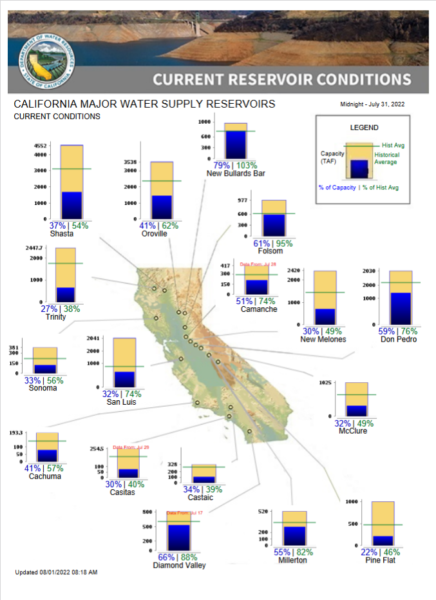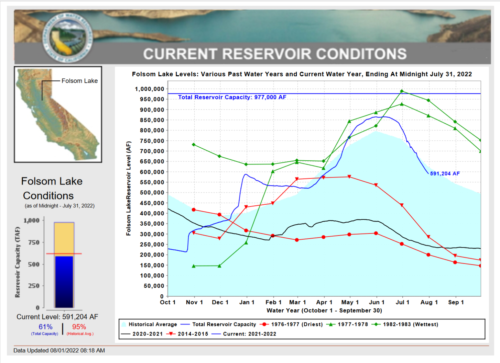 Written by hydrologist Robert Shibatani
Written by hydrologist Robert Shibatani
With two months left in this water year (WY), California’s federal and State water systems will undoubtedly endure and avoid irreparable harm, all things considered. This WY, at least relative to past years, has thankfully not led to calamitous water news. That being said, our thoughts and prayers are with the brave people of Kentucky!
Currently, total combined federal reservoir storage remains around 60% of normal which may surprise a lot of people ensconced in drought rhetoric.
As of yesterday, total water storage in federal reservoirs was approaching 4 million acre-feet (MAF) for the first time this WY and will likely drop below this threshold by early next week. The three largest California federal reservoirs, Shasta, Trinity, and New Melones are at 1,690, 0.667, and 0.716 MAF respectively or, 60, 45 and 54% of their 15-year averages, respectively. Oroville Reservoir is currently storing some 1.465 MAF, representing 73% of its 15-year average.
The outlier, once again is Folsom Reservoir. In fact, Folsom storage remains above 100% of its 15-year average for this time of year, a remarkable achievement given this current WY and the reservoir’s unique position in terms of meeting o Bay-Delta water quality, endangered species, and export constraints! Even more remarkable is that Folsom Reservoir for much of the summer has been able to maintain releases notably above its long-term median (i.e., 3,500 cfs). The big change in system river flow, however, has been the significant reductions in Keswick Dam releases all summer. Releases into the Sacramento River have been around 4,500 cfs, well below the long-term average which has required accommodations from other reservoirs. Over the summer, these shortfalls have been made-up to the extent possible from elevated releases from Oroville and Folsom reservoirs.
 Reservoir depletions have been substantial this month. Storage declines at Shasta, Trinity, New Melones, and Friant reservoirs have been 90,700 acre-feet (AF), 50,100 AF, 70,200 AF and 57,251 AF, respectively. As noted above, with its larger role in delta “balancing” this summer, Folsom Reservoir has been depleted by some 210,800 AF of storage through yesterday.
Reservoir depletions have been substantial this month. Storage declines at Shasta, Trinity, New Melones, and Friant reservoirs have been 90,700 acre-feet (AF), 50,100 AF, 70,200 AF and 57,251 AF, respectively. As noted above, with its larger role in delta “balancing” this summer, Folsom Reservoir has been depleted by some 210,800 AF of storage through yesterday.
When examining the accumulated inflows to date, often viewed as a key indicator of hydrologic vitality, the key federal reservoirs have not suffered as bad as some might have thought. For example, unimpaired inflow-to-date for Shasta, Trinity, New Melones, Folsom and Millerton reservoirs as a percentage of their 15-year averages are 61, 48, 60, 71 and 61%, respectively. This, not surprisingly, is reflected in the precipitation-to-date which are 69, 61, 72, 98 and 60% of normal, respectively, for these same reservoirs. Exports have increased significantly over July, rising from 1,922 cfs at the beginning of the month to over 3,400 cfs yesterday. E/I ratio not surprising was 27% on Friday.
Barring any drastic unanticipated changes, California’s federal/State reservoir systems for its two projects can endure the remaining months of this WY. The fall and early winter will represent a critical period to reestablish vital carryover depleted over these past 2-years.
Prepared by Robert Shibatani
Robert Shibatani, a physical hydrologist with over 35-years combined experience as an international expert witness on reservoir-operations, climate change hydrology, commercial flood damage litigation, and water supply development. He is Managing Partner for The SHIBATANI GROUP International, a division of The SHIBATANI GROUP Inc. and resides in Sacramento, California. robert@theshibatanigroup.com
FOR MORE INFORMATION
Reservoirs
- Daily Reservoir Summary
- Selected Reservoirs, Daily Graphs (interactive)
- CA Data Exchange Center: Reservoirs
- CVP Daily Water Supply Report
Precipitation
- Real-time Rainfall Maps
- Detailed Monthly Precipitation Summary for Water Year
- Center for Western Weather and Water Extremes (CW3E)
Snow
Full Natural Flow Data
Drought/Climate
Water Project Operations
- State Water Project Operations and Delta Status
- Central Valley Project Operations
- Lower Colorado River Operations
Delta conditions
- Bay-Delta Live (Real Time Delta Conditions)
- EcoAtlas (Delta Restoration Projects)
Specialty Portals
- My Water Quality (CA Water Quality Monitoring Council)
- Fish Surveys (Department of Fish and Wildlife)
- NASA GRACE Groundwater and Soil Moisture Conditions


